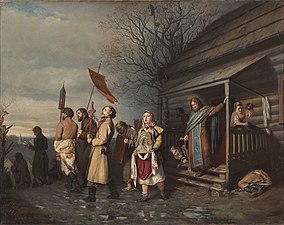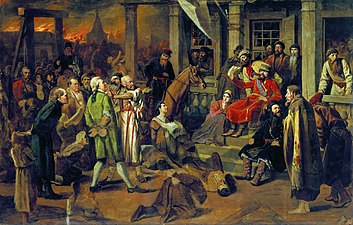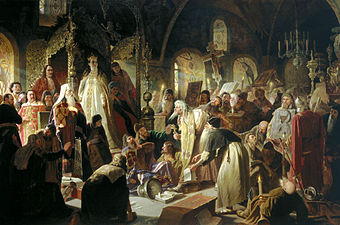Vasily Perov
You can helpexpand this article with text translated fromthe corresponding articlein Russian.(November 2015)Click [show] for important translation instructions.
|
Vasily Grigorevich Perov | |
|---|---|
 Portrait of Vasily Perov byIvan Kramskoi (1881) | |
| Born | Vasily Grigorevich Vasiliev 2 January 1834 |
| Died | 26 May 1882(aged 48) |
| Nationality | Russian |
| Education | Member Academy of Arts (1866) Professor by rank (1870) |
| Alma mater | Moscow School of Painting, Sculpture and Architecture |
| Known for | Painting |
| Notable work | Easter Procession(1865) The Hunters at Rest(1871) Portrait of Fyodor Dostoyevsky(1872) |
| Movement | Realism,Peredvizhniki |
| Awards | Minor silver medal (1856) Grand silver medal (1857) Minor gold medal (1860) |
| Patron(s) | Pavel Tretyakov |
Vasily Grigorevich Perov(Russian:Василий Григорьевич Перов;2 January 1834 [O.S.21 December 1833] – 10 June [O.S. 29 May] 1882) was a Russianpainter,a key figure of the RussianRealistmovement and one of the founding members ofPeredvizhniki.[1]
Life and career[edit]

Vasily Perov was born on 2 January 1834 (21 December 1833 Old Style) inTobolsk,Tobolsk Governorate,Russian Empire,as Vasily Grigorevich Vasiliev (Василий Григорьевич Васильев). Perov was anillegitimateson of the local procuratorbaron,Baron Gregor Gustav Friedrich von Krüdener, who belonged to aGermanandBaltic Germannoble family, which belonged to theUradel,and a Russian, Akulina Ivanova, a native citizen of Tobolsk. Although Perov's parents married soon after his birth, there was no legal way to inherit his father's name and baron title, so he was registered under hisgodfather's surname —Vasiliev.He later changed his surname toPerov— a nickname given to him by his teacher who taught himcalligraphyas a child (the wordperomeansfeatherinRussian).[2]
After completing a course atArzamasuyezdschool, Perov was transferred to theAlexander Stupinart schoolalso located inArzamas.In 1853, Perov was admitted to theMoscow School of Painting, Sculpture and ArchitectureinMoscow,where he learned from several renowned artists.[3] In 1856, Perov was awarded with a minor silver medal, presented to theImperial Academy of Arts,for his sketch of a boy's head. Later the Academy gave him many other awards: in 1857 a major silver medal forCommissary of Rural Police Investigating,a minor golden medal for theScene on a Graveand theSon of aDyakPromoted to First Rank,and in 1861 a major golden medal forSermon in a Village.

In 1862, after receiving the right to a state-paid trip abroad together with a golden medal, Perov traveled toWestern Europe,visiting severalGermancities, and thenParis.During this time he created paintings depicting scenes from Europeanstreetlife,such as theVendor of statuettes,theSavoyard,theOrgan-Grinder in Paris,theMusicians and the Bystanders,and theParis Ragpickers. Returning toMoscowearly, from 1865 to 1871 Perov created his best known pieces,The Queue at The Fountain,A Meal in the Monastery,Last Journey,Troika,theLent Monday,Arrival of a New Governess in a Merchant House,theDrawing Teacher,A Scene at the Railroad,theLast Tavern at Town Gate,theBirdcatcher,theFisherman,and theHunters at Rest. In 1866, Perov received the title of anacademician,and in 1871 the position of a professor at Moscow School of Arts, Sculpture and Architecture. It was around this period that Perov joined thePeredvizhniki,a collective of Russian realist painters formed as an artists cooperative in protest of academic restrictions.

Perov died on 10 June (29 May O.S.), 1882 in the village Kuzminki, nowKuzminki Districtof Moscow) fromtuberculosis,and his body was interred at theDonskoy Cemetery.
Selected works[edit]
-
Self-portrait(1851)
-
Self-portrait(1870)
-
Paris Ragman(1864)
-
Alexander Ostrovsky(1871)
-
Fyodor Dostoyevsky(1872)
-
Old man(1868)
-
A Scene at the Railroad(1868)
-
The Bird-Catcher(1870)
-
Sleeping Children(1870)
-
Easter Procession
-
A Governess Arriving at a Merchant's House
-
Pugachev'sJudgement(1879)
-
Nikita Pustosviat.Dispute on the Confession of Faith(1881)
-
Drinking tea in Mytishchi, near Moscow.
References[edit]
- ^"vasily-perov".www.visual-arts-cork.com.RetrievedJanuary 2,2016.
- ^Perov, Vasily Grigorievichin theRussian Biographical Dictionaryin 25 Volumes. Saint Petersburg, 1896—1918.
- ^"biography/Vasily-G-Perov".www.britannica.com.RetrievedJanuary 2,2016.
External links[edit]
- Members of the Imperial Academy of Arts
- Academic staff of the Imperial Academy of Arts
- Awarded with a large gold medal of the Academy of Arts
- 1834 births
- 1882 deaths
- People from Tobolsk
- People from Tobolsky Uyezd
- Realist painters from the Russian Empire
- Peredvizhniki
- Male painters from the Russian Empire
- 19th-century painters from the Russian Empire
- Tuberculosis deaths in the Russian Empire
- 19th-century deaths from tuberculosis
- 19th-century male artists from the Russian Empire
- Moscow School of Painting, Sculpture and Architecture alumni
- Academic staff of the Moscow School of Painting, Sculpture and Architecture














